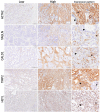A Novel Gene List Identifies Tumors with a Stromal-Mesenchymal Phenotype and Worse Prognosis in Gastric Cancer
- PMID: 37296997
- PMCID: PMC10252086
- DOI: 10.3390/cancers15113035
A Novel Gene List Identifies Tumors with a Stromal-Mesenchymal Phenotype and Worse Prognosis in Gastric Cancer
Abstract
Background: Molecular biomarkers that predict disease progression can help identify tumor subtypes and shape treatment plans. In this study, we aimed to identify robust biomarkers of prognosis in gastric cancer based on transcriptomic data obtained from primary gastric tumors.
Methods: Microarray, RNA sequencing, and single-cell RNA sequencing-based gene expression data from gastric tumors were obtained from public databases. Freshly frozen gastric tumors (n = 42) and matched FFPE (formalin-fixed, paraffin-embedded) (n = 40) tissues from a Turkish gastric cancer cohort were used for quantitative real-time PCR and immunohistochemistry-based assessments of gene expression, respectively.
Results: A novel list of 20 prognostic genes was identified and used for the classification of gastric tumors into two major tumor subgroups with differential stromal gene expression ("Stromal-UP" (SU) and "Stromal-DOWN" (SD)). The SU group had a more mesenchymal profile with an enrichment of extracellular matrix-related gene sets and a poor prognosis compared to the SD group. Expression of the genes within the signature correlated with the expression of mesenchymal markers ex vivo. A higher stromal content in FFPE tissues was associated with shorter overall survival.
Conclusions: A stroma-rich, mesenchymal subgroup among gastric tumors identifies an unfavorable clinical outcome in all cohorts tested.
Keywords: biomarker; gastric cancer; prognosis; stroma.
Conflict of interest statement
The authors declare no conflict of interest.
Figures




Similar articles
-
Weighted Gene Co-expression Network Analysis Identifies a Cancer-Associated Fibroblast Signature for Predicting Prognosis and Therapeutic Responses in Gastric Cancer.Front Mol Biosci. 2021 Oct 8;8:744677. doi: 10.3389/fmolb.2021.744677. eCollection 2021. Front Mol Biosci. 2021. PMID: 34692770 Free PMC article.
-
Clinical relevance of DNA microarray analyses using archival formalin-fixed paraffin-embedded breast cancer specimens.BMC Cancer. 2011 Jun 16;11:253:1-13. doi: 10.1186/1471-2407-11-253. BMC Cancer. 2011. PMID: 21679412 Free PMC article.
-
Identification of Prognostic Biomarkers Originating From the Tumor Stroma of Betel Quid-Associated Oral Cancer Tissues.Front Oncol. 2021 Nov 16;11:769665. doi: 10.3389/fonc.2021.769665. eCollection 2021. Front Oncol. 2021. PMID: 34869001 Free PMC article.
-
Intratumor stromal proportion predicts aggressive phenotype of gastric signet ring cell carcinomas.Gastric Cancer. 2017 Jul;20(4):591-601. doi: 10.1007/s10120-016-0669-2. Epub 2016 Nov 17. Gastric Cancer. 2017. PMID: 27858181
-
A novel necroptosis-related gene index for predicting prognosis and a cold tumor immune microenvironment in stomach adenocarcinoma.Front Immunol. 2022 Oct 27;13:968165. doi: 10.3389/fimmu.2022.968165. eCollection 2022. Front Immunol. 2022. PMID: 36389725 Free PMC article. Review.
Cited by
-
Breast Cancer Plasticity after Chemotherapy Highlights the Need for Re-Evaluation of Subtyping in Residual Cancer and Metastatic Tissues.Int J Mol Sci. 2024 May 31;25(11):6054. doi: 10.3390/ijms25116054. Int J Mol Sci. 2024. PMID: 38892243 Free PMC article.
-
Integrating transcriptomic data and digital pathology for NRG-based prediction of prognosis and therapy response in gastric cancer.Ann Med. 2024 Dec;56(1):2426758. doi: 10.1080/07853890.2024.2426758. Epub 2024 Nov 11. Ann Med. 2024. PMID: 39527470 Free PMC article.
References
-
- Marano L., D’Ignazio A., Cammillini F., Angotti R., Messina M., Marrelli D., Roviello F. Comparison between 7th and 8th edition of AJCC TNM staging system for gastric cancer: Old problems and new perspectives. Transl. Gastroenterol. Hepatol. 2019;4:22. doi: 10.21037/tgh.2019.03.09. - DOI - PMC - PubMed
Grants and funding
LinkOut - more resources
Full Text Sources

